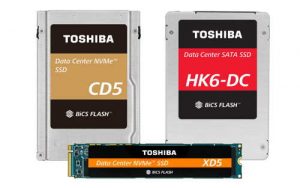Toshiba Memory Unveils CD5, XD5 and HK6-DC Data Center SSDs Featuring BiCS Flash 64-Layer 3D Memory
Up 7,7GB for CD5 U.2, 3.8TB for M.2 22110 XD5, and 3.8TB for HK6-DC 6Gb SATA SSD
This is a Press Release edited by StorageNewsletter.com on March 26, 2018 at 2:35 pmToshiba Memory America, Inc. (TMA), U.S.-based subsidiary of Toshiba Memory Corporation, has enhanced its portfolio of SSDs for the data center with a 3D flash memory-based lineup of PCIe NVMe and SATA SSDs in multiple form factors.
The CD5, XD5 and HK6-DC SSDs enable infrastructure managers to address performance and workload demands by offering performance and reliability with lower operating power for read-intensive applications such as NoSQL databases, big data analytics and streaming media.
“Demand for flash storage in data centers continues to grow rapidly – with capacity shipped into the enterprise expected to increase at a 58 percent CAGR through 2021,” said Jeff Janukowicz, research VP, solid state drives and enabling technologies, IDC “In order for hyperscale, virtualization, automation/orchestration and software-defined storage applications to thrive, cloud data centers must meet specific workload requirements. Toshiba’s latest data center SSDs are designed to help customers address these demanding environments and realize the most value from their flash storage.”
This lineup of SSDs utilize the company’s next-generation BiCS FLASH 3D flash memory, which is based on the firm’s 64-layer architecture and uses 3-bit-per-cell (triple-level cell, TLC) technology. Additionally, the CD5, XD5 and HK6-DC SSD families are designed with end-to-end vertical integration to deliver quality and reliability.
These PCIe NVMe SSDs are designed for multiple data center workload profiles. The CD5 Series supports capacities ranging from 960GB to 7,680GB (1) in a U.2 form factor, delivering 500,000/35,000 random read/write IOPS and up to 3,140/1,980MB/s sequential read/write performance within a 9-14W power envelope. (2)
The XD5 Series is a small footprint M.2 22110 form factor SSD that supports capacities up to 3.84TB and delivers up to 2,600/890MB/s sequential read/write performance in a 7W power envelope. These SSDs are optimized for low latency and performance consistency in read-intensive workloads, and targeted at Open Compute Projec and hyper-scale/cloud applications.
The HK6-DC Series is a 6Gb SATA SSD and is available in 960GB, 1.92 and 3.84TB capacities. This read-intensive, latency optimized SSD delivers up to 85,000 random read IOPS and up to 550MB/s sequential read performance. These performance numbers are more than 400 times better than those of a 15,000 rpm HDD. They also represent continued improvements over previous generation SATA SSDs.
“Today’s data centers continually face heavy workloads and require high reliability, low-power solutions able to deliver consistent application performance,” said Neville Ichhaporia, director , client and data center SSD marketing, TMA. “Our new lineup of BiCS FLASH-based NVMe and SATA SSDs address these demands with a combination of great performance, low latency and high reliability to provide efficient storage solutions for cloud environments.”
The company’s data center SSDs feature power loss protection and support cryptographic erase support for secure removal of data. They also utilize AES 256-bit data to encrypt data securely without the performance impact associated with software-based solutions. Designed to provide IO consistency, the firm’s SSDs include a five-year limited warranty.
The company will begin shipping samples of the CD5, XD5 and HK6-DC SSD families to select customers in 2Q18.
(1) Definition of capacity: 1TB is 1,000,000,000,000 bytes. A computer operating system, however, reports storage capacity using powers of two for the definition of 1TB = 240 = 1,099,511,627,776 bytes and therefore shows less storage capacity. Available storage capacity (including examples of various media files) will vary based on file size, formatting, settings, software and operating system and/or pre-installed software applications, or media content. Actual formatted capacity may vary.
(2) Read and write speed may vary depending on the host devices, read and write conditions, and file size.













 Subscribe to our free daily newsletter
Subscribe to our free daily newsletter
